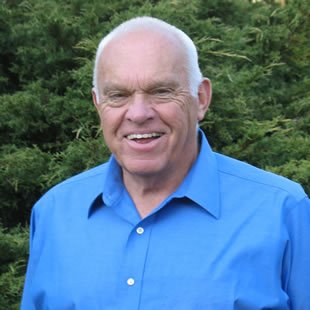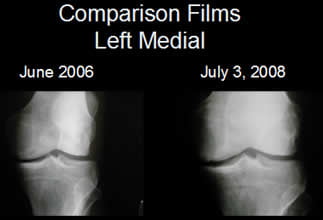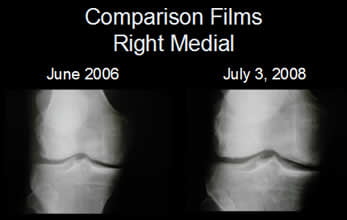Here is my story. I tore my right knee medial meniscus (cushion cartilage) about 20 years ago while playing golf with friends at Mission Hills in Palm Desert. I did it with a single golf swing. I knew full well the diagnosis, but like most patients, I used high level of denial and kept playing. The knee kept catching and swelled up. With a flush of testosterone and heightened level of male ego I played on and finished the round. The tear was probably small and gradually the symptoms lessened. The normal medical history of a small tear is that the cushion cartilage is that it shrinks and becomes less symptomatic over time. So it was with me. I bothered me off and on over the years, but not so bad that I wanted surgery.
We now fast forward ten years to 1997. I am playing golf in a member guest invitational club tournament. In the middle of the match, I have a ball resting deep in the rough on a side of a hill. I am flowing in all the competitive juices typical of a weekend athlete. I must make the shot of a life time from this adverse lie. I take a mighty swing and rip the ball out of the rough, but the result was no where near the miracle I had envisioned. I had previously read that a great golfer envisions his shots. What happened I did not envision.
I simultaneously felt a rip in both knees. Remember I am a very smart orthopedic surgeon, so I knew instantly I tore both medial menisci. Still flush with the testosterone and competitive spirit, but not so smart a person, I played on. There was massive swelling of both knees. You may know the old adage; a doctor who treats himself has a fool for a patient. I was no different. I also played the next two days with my envisioned miracle extended beyond the failed golf shot to spontaneous healing of my injured knees. I got no miracle.
Still not short on denial I waited several weeks before submitting to surgery in November of 1997. According to the old adage, I remained a fool of a patient. I insisted upon surgery on both knees at one time as a matter of convenience. I was wrong again. Both knees had torn medial menisci, hundreds of loose cartilage fragments from the sheared off surface of the end of the thigh bone at the knee. My idea of convenience ended immediately after surgery. It is not possible to be off both knees at the same time. I think they told me that before I insisted on both knees at once. I then found myself sitting in a chair. I made a futile attempt to get around on crutches protecting one knee at a time. Obviously recovery was slow even for a self proclaimed “superdoc”. Funny how pathology and surgery plays out the same independent of how much one thinks they know.
My condition gradually deteriorated so that by summer of 2006 I had constant swelling of the knee joints. My pain was constant. I could not straighten either knee. I was bowlegged. I could not walk up stairs or climb a latter. I could not walk any distance even in an airport terminal. I sat in the blue chairs for the disabled. I waited ironically for the golf cart transportation to the next gate. I could not play golf, event though I tried. My legs were becoming more bowed. My right knee was markedly swollen.
At this point everyone but me is conscious of the old adage mentioned above about surgeons treating themselves. Surgeons know too well the benefits and risks of surgery. They also know the difference between major and minor surgery. Minor surgery is if it is on you. Major surgery is if it is on me. So I went to a former partner of mine and asked for x-rays of both knees. I did not want to see them as I knew they would show arthritis. I only wanted to document the historical status. I asked that he drain the worst knee and put a cortisone shot into that knee. He was very kind in accommodating the foolish patient.
The medical indications were present of a high tibial osteotomy or unicompartmental joint replacement. Alternative medicine was becoming more popular about this time and for a good reason. So I started looking for an alternative for major surgery. I searched the literature and learned the potential benefit of wedges in shoes to unload the inner portion of the knee. I also knew that the deformity of my lower extremities due to structural contractures needed to be corrected if I was to have a benefit from the dynamic effect of the shoe wedges.
Although I thought I was a knee expert before all this personal experience, I now know more about care of the arthritic knee than ever before. Mine.
I subsequently devised treatment methods and my condition markedly improved. I had no swelling since. I can walk 5 miles if I wanted. I can be on my feet 8-10 hours without a problem. I had repeat x-rays in 2008 and they showed 2 millimeter wider joint space of both knees. This is circumstantial evidence that the cartilage has recovered.



